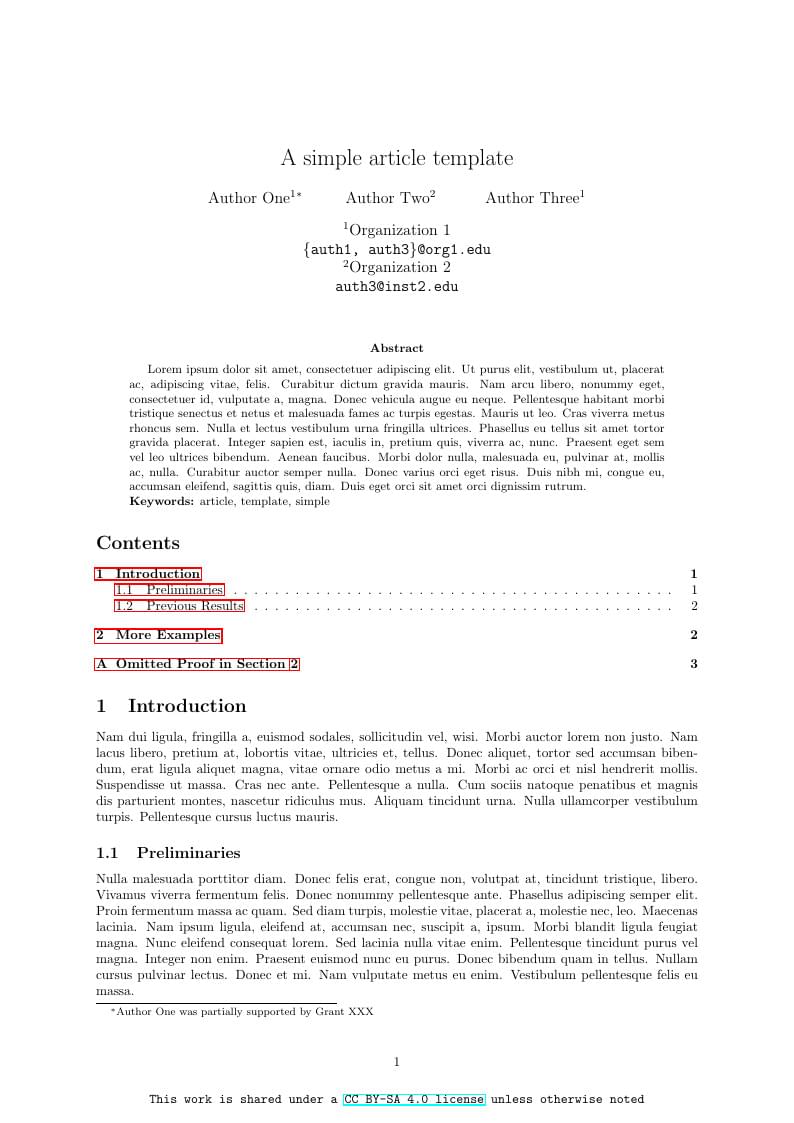
A simple article template
Author:
Duc A. Hoang
Last Updated:
7 yıl önce
License:
Creative Commons CC BY 4.0
Abstract:
A simple template for writing articles

\begin
Discover why over 20 million people worldwide trust Overleaf with their work.
A simple template for writing articles

\begin
Discover why over 20 million people worldwide trust Overleaf with their work.
\documentclass[a4paper]{article}
\usepackage[pages=all, color=black, position={current page.south}, placement=bottom, scale=1, opacity=1, vshift=5mm]{background}
\SetBgContents{
\tt This work is shared under a \href{https://creativecommons.org/licenses/by-sa/4.0/}{CC BY-SA 4.0 license} unless otherwise noted
} % copyright
\usepackage[margin=1in]{geometry} % full-width
% AMS Packages
\usepackage{amsmath}
\usepackage{amsthm}
\usepackage{amssymb}
% Unicode
\usepackage[utf8]{inputenc}
\usepackage{hyperref}
\hypersetup{
unicode,
% colorlinks,
% breaklinks,
% urlcolor=cyan,
% linkcolor=blue,
pdfauthor={Author One, Author Two, Author Three},
pdftitle={A simple article template},
pdfsubject={A simple article template},
pdfkeywords={article, template, simple},
pdfproducer={LaTeX},
pdfcreator={pdflatex}
}
% Vietnamese
%\usepackage{vntex}
% Natbib
\usepackage[sort&compress,numbers,square]{natbib}
\bibliographystyle{mplainnat}
% Theorem, Lemma, etc
\theoremstyle{plain}
\newtheorem{theorem}{Theorem}
\newtheorem{corollary}[theorem]{Corollary}
\newtheorem{lemma}[theorem]{Lemma}
\newtheorem{claim}{Claim}[theorem]
\newtheorem{axiom}[theorem]{Axiom}
\newtheorem{conjecture}[theorem]{Conjecture}
\newtheorem{fact}[theorem]{Fact}
\newtheorem{hypothesis}[theorem]{Hypothesis}
\newtheorem{assumption}[theorem]{Assumption}
\newtheorem{proposition}[theorem]{Proposition}
\newtheorem{criterion}[theorem]{Criterion}
\theoremstyle{definition}
\newtheorem{definition}[theorem]{Definition}
\newtheorem{example}[theorem]{Example}
\newtheorem{remark}[theorem]{Remark}
\newtheorem{problem}[theorem]{Problem}
\newtheorem{principle}[theorem]{Principle}
\usepackage{graphicx, color}
\graphicspath{{fig/}}
%\usepackage[linesnumbered,ruled,vlined,commentsnumbered]{algorithm2e} % use algorithm2e for typesetting algorithms
\usepackage{algorithm, algpseudocode} % use algorithm and algorithmicx for typesetting algorithms
\usepackage{mathrsfs} % for \mathscr command
\usepackage{lipsum}
% Author info
\title{A simple article template}
\author{Author One$^1$\thanks{Author One was partially supported by Grant XXX} \and Author Two$^2$ \and Author Three$^1$}
\date{
$^1$Organization 1 \\ \texttt{\{auth1, auth3\}@org1.edu}\\%
$^2$Organization 2 \\ \texttt{auth3@inst2.edu}\\[2ex]%
% \today
}
\begin{document}
\maketitle
\begin{abstract}
\lipsum[1]
\noindent\textbf{Keywords:} article, template, simple
\end{abstract}
\tableofcontents
\section{Introduction}
\label{sec:intro}
\lipsum[2]
\subsection{Preliminaries}
\label{sec:pre}
\lipsum[3]
\subsection{Previous Results}
\label{sec:prev-results}
Null graphs are discussed in \cite{HararyR74}
The concept of ``internally stable set'' was used in \cite{Berge57, Berge58}.
\begin{theorem}
\label{thrm:1}
\lipsum[4]
\end{theorem}
\begin{proof}
content...
\end{proof}
\begin{corollary}
\label{cor:1}
\lipsum[5]
\end{corollary}
Unordered List (taken from Overleaf)
\begin{itemize}
\item The individual entries are indicated with a black dot, a so-called bullet.
\item The text in the entries may be of any length.
\end{itemize}
Ordered List (taken from Overleaf)
\begin{enumerate}
\item The labels consists of sequential numbers.
\item The numbers starts at 1 with every call to the enumerate environment.
\end{enumerate}
\begin{table}[ht]
\centering
\begin{tabular}{|c|c|}
\hline
\textbf{Odd} & \textbf{Even} \\
\hline\hline
One & Two \\
\hline
Three & Four \\
\hline
\end{tabular}
\caption{This is a table}
\label{tbl:1}
\end{table}
Table~\ref*{tbl:1} is an example of a table.
\section{More Examples}
\label{sec:examples}
Now we include a figure.
(See Figure~\ref{fig:example}.)
\begin{figure}[ht]
\centering
\includegraphics[width=0.3\textwidth]{example}
\caption{An example of a figure}
\label{fig:example}
\end{figure}
\paragraph{Acknowledgements} \lipsum[6]
% \newpage
\bibliography{refs}
\appendix
\section{Omitted Proof in Section~\ref{sec:examples}}
\label{app:1}
\lipsum[7]
\end{document}